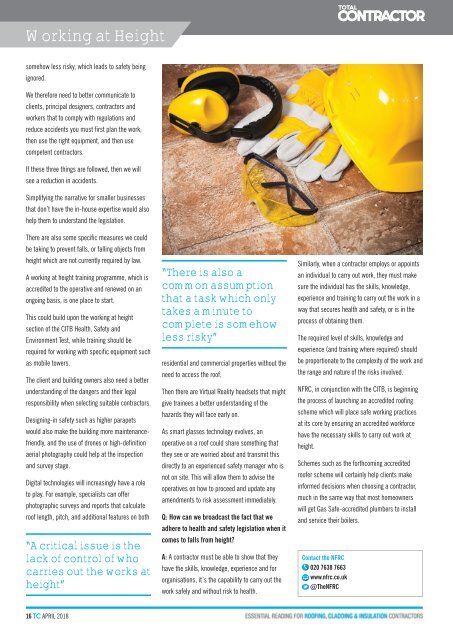April 2018
Create successful ePaper yourself
Turn your PDF publications into a flip-book with our unique Google optimized e-Paper software.
Working at Height<br />
somehow less risky, which leads to safety being<br />
ignored.<br />
We therefore need to better communicate to<br />
clients, principal designers, contractors and<br />
workers that to comply with regulations and<br />
reduce accidents you must first plan the work,<br />
then use the right equipment, and then use<br />
competent contractors.<br />
If these three things are followed, then we will<br />
see a reduction in accidents.<br />
Simplifying the narrative for smaller businesses<br />
that don’t have the in-house expertise would also<br />
help them to understand the legislation.<br />
There are also some specific measures we could<br />
be taking to prevent falls, or falling objects from<br />
height which are not currently required by law.<br />
A working at height training programme, which is<br />
accredited to the operative and renewed on an<br />
ongoing basis, is one place to start.<br />
This could build upon the working at height<br />
section of the CITB Health, Safety and<br />
Environment Test, while training should be<br />
required for working with specific equipment such<br />
as mobile towers.<br />
The client and building owners also need a better<br />
understanding of the dangers and their legal<br />
responsibility when selecting suitable contractors.<br />
Designing-in safety such as higher parapets<br />
would also make the building more maintenancefriendly,<br />
and the use of drones or high-definition<br />
aerial photography could help at the inspection<br />
and survey stage.<br />
Digital technologies will increasingly have a role<br />
to play. For example, specialists can offer<br />
photographic surveys and reports that calculate<br />
roof length, pitch, and additional features on both<br />
“A critical issue is the<br />
lack of control of who<br />
carries out the works at<br />
height”<br />
“There is also a<br />
common assumption<br />
that a task which only<br />
takes a minute to<br />
complete is somehow<br />
less risky”<br />
residential and commercial properties without the<br />
need to access the roof.<br />
Then there are Virtual Reality headsets that might<br />
give trainees a better understanding of the<br />
hazards they will face early on.<br />
As smart glasses technology evolves, an<br />
operative on a roof could share something that<br />
they see or are worried about and transmit this<br />
directly to an experienced safety manager who is<br />
not on site. This will allow them to advise the<br />
operatives on how to proceed and update any<br />
amendments to risk assessment immediately.<br />
Q: How can we broadcast the fact that we<br />
adhere to health and safety legislation when it<br />
comes to falls from height?<br />
A: A contractor must be able to show that they<br />
have the skills, knowledge, experience and for<br />
organisations, it’s the capability to carry out the<br />
work safely and without risk to health.<br />
Similarly, when a contractor employs or appoints<br />
an individual to carry out work, they must make<br />
sure the individual has the skills, knowledge,<br />
experience and training to carry out the work in a<br />
way that secures health and safety, or is in the<br />
process of obtaining them.<br />
The required level of skills, knowledge and<br />
experience (and training where required) should<br />
be proportionate to the complexity of the work and<br />
the range and nature of the risks involved.<br />
NFRC, in conjunction with the CITB, is beginning<br />
the process of launching an accredited roofing<br />
scheme which will place safe working practices<br />
at its core by ensuring an accredited workforce<br />
have the necessary skills to carry out work at<br />
height.<br />
Schemes such as the forthcoming accredited<br />
roofer scheme will certainly help clients make<br />
informed decisions when choosing a contractor,<br />
much in the same way that most homeowners<br />
will get Gas Safe-accredited plumbers to install<br />
and service their boilers.<br />
Contact the NFRC<br />
020 7638 7663<br />
www.nfrc.co.uk<br />
@TheNFRC<br />
16 TC APRIL <strong>2018</strong>

















